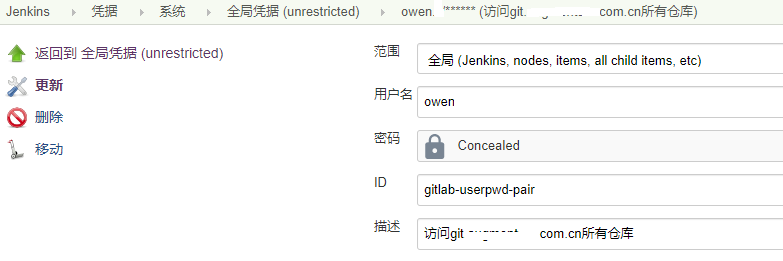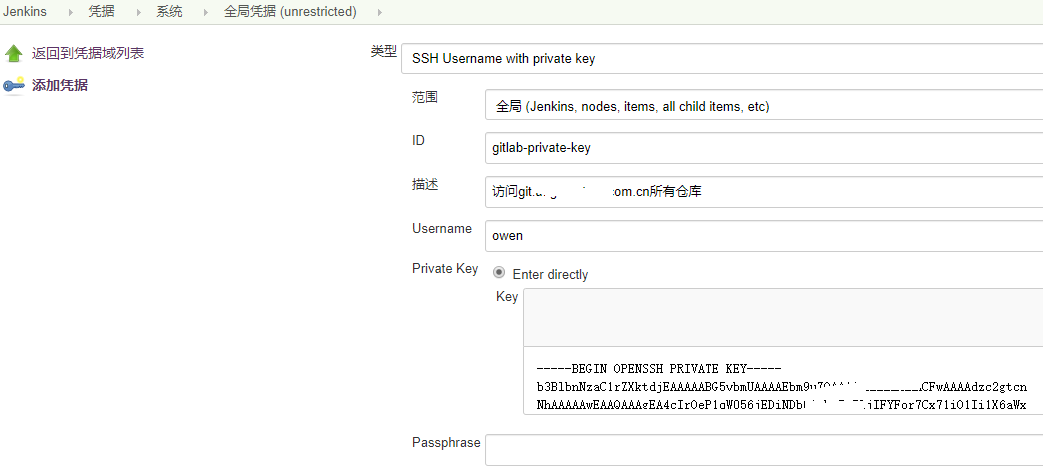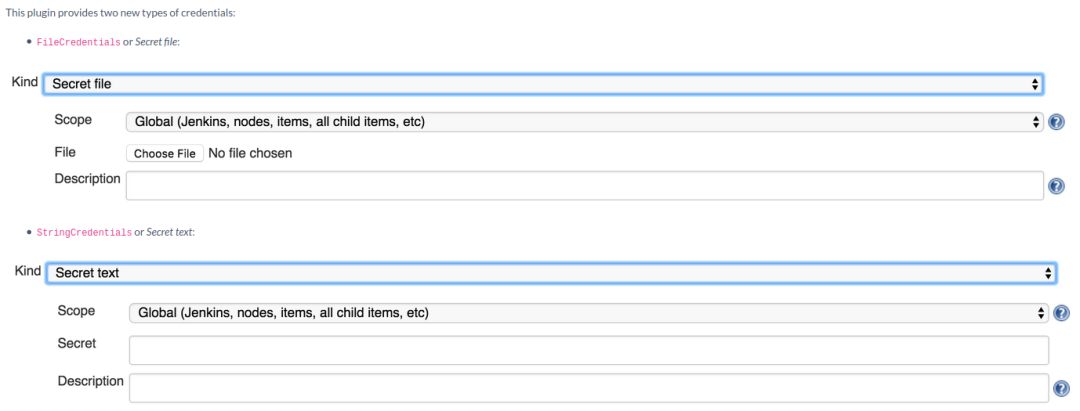Jenkins 凭证管理 - 看这一篇就够了~
点击上方蓝色字体,选择“标星公众号”
优质文章,第一时间送达
作者 | IT胖
来源 | urlify.cn/BzA3ea
许多三方网站和应用可以与Jenkins交互,如Artifact仓库,基于云的存储系统和服务等. 在Jenkins中添加/配置credentials,Pipeline项目就可以使用 credentials 与三方应用交互

Credential 类型
参考:https://jenkins.io/zh/doc/book/using/using-credentials/
Jenkins可以存储以下类型的credentials:
Secret text - API token之类的token (如GitHub个人访问token)
Username and password - 可以为独立的字段,也可以为冒号分隔的字符串:username:password(更多信息请参照 处理 credentials)
Secret file - 保存在文件中的加密内容
SSH Username with private key - SSH 公钥/私钥对
Certificate - a PKCS#12 证书文件 和可选密码
Docker Host Certificate Authentication credentials.
Credential 安全
为了最大限度地提高安全性,在Jenins中配置的 credentials 以加密形式存储在Jenkins 主节点上(用Jenkins ID加密),并且 只能通过 credentials ID 在Pipeline项目中获取
这最大限度地减少了向Jenkins用户公开credentials真实内容的可能性,并且阻止了将credentials复制到另一台Jenkins实例
Credential 创建
选择适合的凭证类型

创建 “Username and password” 凭证

创建 “SSH Username with private key” 凭证

Credential ID 定义
在 ID 字段中,必须指定一个有意义的
Credential ID- 例如 jenkins-user-for-xyz-artifact-repository。注意: 该字段是可选的。如果您没有指定值, Jenkins 则Jenkins会分配一个全局唯一ID(GUID)值。请记住: 一旦设置了credential ID,就不能再进行更改。
Credential 使用
参考:https://www.jenkins.io/doc/book/pipeline/jenkinsfile/#handling-credentials
存储在Jenkins中的credentials可以被使用:
适用于Jenkins的任何地方 (即全局 credentials),
通过特定的Pipeline项目/项目 (在 处理 credentials 和 使用Jenkinsfile部分了解更多信息),
由特定的Jenkins用户 (如 Pipeline 项目中创建 Blue Ocean的情况).
Blue Ocean 自动生成一个 SSH 公共/私有密钥对, 确保 SSH 公共/私有秘钥对在继续之前已经被注册到你的Git服务器
实际使用中,下面几个场景会用到creential
gitlab 访问、API调用
jenkins slave 创建
Credential 相关插件
注意: 上述 Credential 类型都依赖于 jenkins插件,同样jenkins pipeline 也需要这些插件的安装以支持代码片段
Credentials Binding:https://plugins.jenkins.io/credentials-binding/
environment {
MAGE_REPO_CREDENTIALS = credentials('COMPOSER_REPO_MAGENTO')
COMPOSER_AUTH = """{
"http-basic": {
"repo.magento.com": {
"username": "${env.MAGE_REPO_CREDENTIALS_USR}",
"password": "${env.MAGE_REPO_CREDENTIALS_PSW}"
}
} }"""
}For other credential types
For secret text, usernames and passwords, and secret files
Jenkins Plain Credentials Plugin: https://plugins.jenkins.io/plain-credentials/

SSH Credentials: https://plugins.jenkins.io/ssh-credentials/
withCredentials([usernamePassword(credentialsId: 'amazon', usernameVariable: 'USERNAME', passwordVariable: 'PASSWORD')]) {
// available as an env variable, but will be masked if you try to print it out any which way
// note: single quotes prevent Groovy interpolation; expansion is by Bourne Shell, which is what you want
sh 'echo $PASSWORD'
// also available as a Groovy variable
echo USERNAME
// or inside double quotes for string interpolation
echo "username is $USERNAME"
}
最佳实践
为了便于管理和使用, 强烈建议使用统一的约定来指定credential ID
建议使用类似下面的format做为credential ID, 便于jenkinsfile开发时直接使用,同时在”描述“里写清楚credential的作用
gitlab-api-token、gitlab-private-key、gitlab-userpwd-pair、harbor-xxx-xxx
实践:
如下所示,将凭证使用统一的ID命名之后,便于复用,凭证定义一次,可多次,多个地方统一使用,无论是后期维护,复用都非常方便!
environment {
// HARBOR="harbor.devopsing.site"
HARBOR_ACCESS_KEY = credentials('harbor-userpwd-pair')
SERVER_ACCESS_KEY = credentials('deploy-userpwd-pair')
}
.....
docker login --username=${HARBOR_ACCESS_KEY_USR} --password=${HARBOR_ACCESS_KEY_PSW} ${HARBOR}
sshpass -p "${SERVER_ACCESS_KEY_PSW}" ssh -o StrictHostKeyChecking=no ${SERVER_ACCESS_KEY_USR}@${DEPLOY_SERVER} "$runCmd"
粉丝福利:实战springboot+CAS单点登录系统视频教程免费领取
???
?长按上方微信二维码 2 秒 即可获取资料
感谢点赞支持下哈 
